This country profile presents the administrative data collected in Latvia during the 2023–2024 data collection exercise with the support of national data providers and national researchers.
The list of 13 indicators developed by the European Institute for Gender Equality (EIGE) for the purposes of this data collection exercise is presented in Annex 1.
The data collected in other countries and the methodological report are published in EIGE’s Gender Statistics Database.
Key findings of EIGE’s 2023–2024 data collection exercise
This section outlines the main findings of EIGE’s most recent administrative data collection exercise on intimate partner violence and domestic violence in Latvia.
Main findings
-
Victims of intimate partner violence and domestic violence
- More than 4 out of 5 victims of intimate partner violence are women (85 % in 2022).
- Roughly half of victims of domestic violence (excluding intimate partner violence) are women (49 % in 2022).
- Physical and economic violence are the most common forms of intimate partner violence and domestic violence against women that are recorded by police each year.
-
Femicide
- In 2022, police data shows that 4 women were killed by intimate partners, and 18 women were killed by domestic perpetrators.
- During this same year, women represented all victims of intimate partner homicide (100 %), and most victims of domestic homicide (58 %).
-
Rape
- In 2022, 168 victims of rape committed by any perpetrator were recorded by police.
- During this same year, women represented 93 % of victims of rape committed by any perpetrator (157 out of 168).
Women are disproportionately affected by intimate partner violence
EIGE’s police indicators mainly collect data on victims of intimate partner violence, domestic violence and violence in ‘any relationship’. EIGE defines a victim as ‘a natural person who has suffered harm, including physical, mental or emotional harm or economic loss which was directly caused by a criminal offence’.
Findings from EIGE’s data collection exercise show that intimate partner violence and domestic violence have the greatest impact on women. Women in Latvia comprise 85 % of victims of intimate partner violence recorded by police (based on data from 2022).
At the same time, women represent 49 % of victims of domestic violence (excluding intimate partner violence), and 43 % of victims of violence in ‘any relationship’ (based on data from 2022).
Figure 1 Proportion of female victims of intimate partner violence, domestic violence, and violence in any relationship recorded by police (Indicator 1), 2022
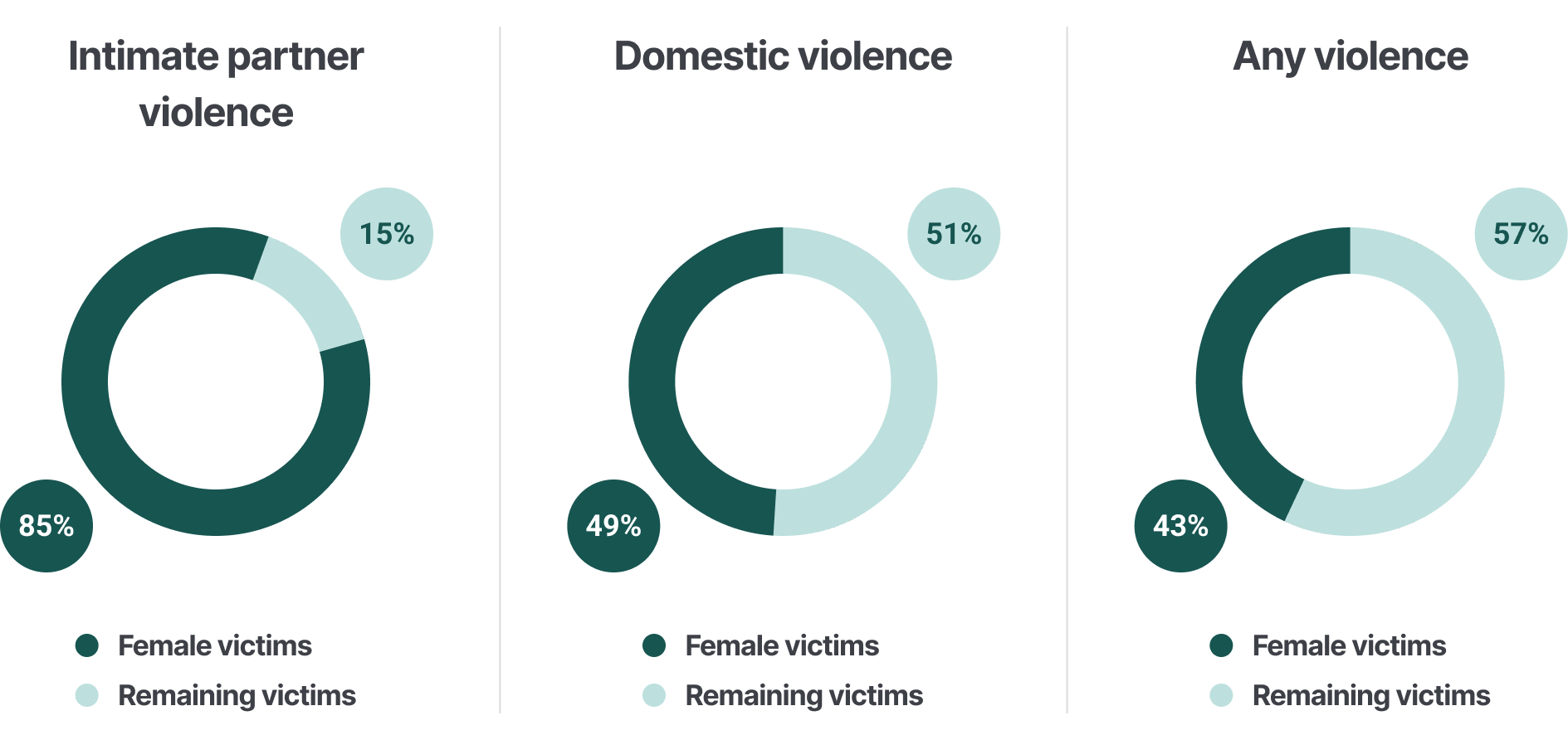
Intimate partner violence
EIGE defines intimate partner violence as ‘any act of physical, sexual, psychological or economic violence that occurs between former or current spouses or partners, whether or not the perpetrator shares or has shared the same residence with the victim’.
In Latvia, no legal definition of intimate partner violence exists. The data on intimate partner violence refers to violence between current and former spouses, as well as current and former cohabitating partners. Current and former non-cohabitating partners are excluded from the data.
Victims of intimate partner violence
In Latvia, women represented 85 % of intimate partner violence victims recorded by police in 2022 (142 out of 167). During the year, police recorded an even greater number of offences of intimate partner violence against women victims (161 offences).
Figure 2 Annual number of female and total victims of intimate partner violence recorded by police (indicator 1), 2014–2022

The annual number of women victims of intimate partner violence recorded by police has fluctuated over recent years, with the highest number recorded in 2020 (165 victims). Fluctuations in figures may be attributed to various factors, such as changes in data collection systems and improvements in processes for identifying victims.
It should also be noted that some victims that were recorded by police in later years may have reported incidents of violence that occurred in earlier years (e.g., in response to new awareness raising campaigns or improved access to support services).
Findings from the latest EU-GBV survey show that 30 % of ever-partnered women in Latvia have experienced psychological, physical (including threats), or sexual violence by an intimate partner in their lifetime.
Survey results also reveal that 14 % of ever-partnered women in Latvia who have experienced physical or sexual intimate partner violence during their lifetime have suffered from repeated victimisation.
Victims of specific forms of intimate partner violence
During EIGE’s 2023-2024 data collection exercise, national data providers in Latvia shared data on the annual number of victims of physical, psychological, sexual, and economic intimate partner violence recorded by police (Indicators 4-7).
Figure 3 Annual number of female and total victims of physical, psychological, sexual, and economic intimate partner violence recorded by police (Indicators 4-7) 2014-2022
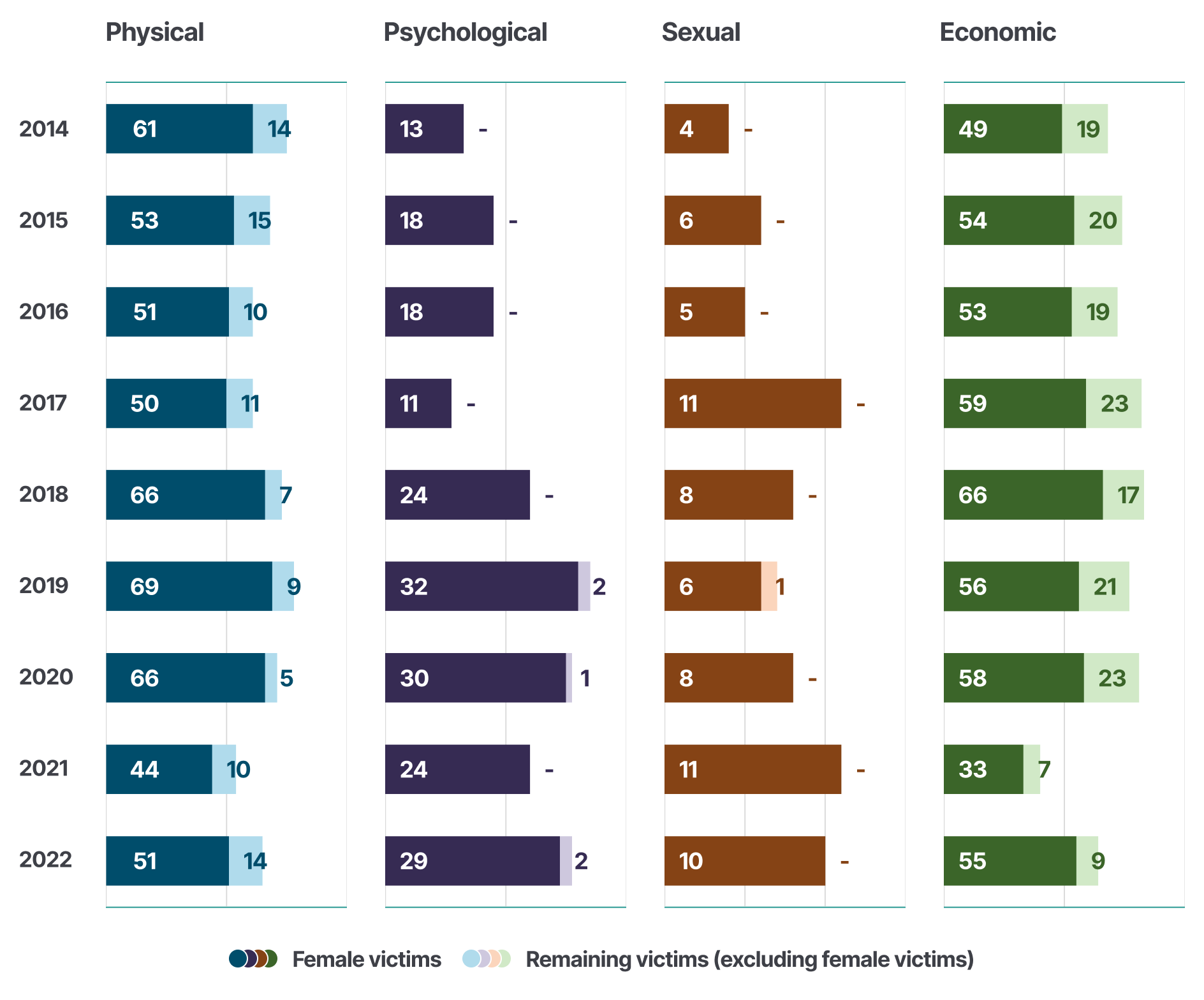
EIGE’s data shows that the police record a greater number of women victims of physical intimate partner violence than of psychological intimate partner violence each year. However, data from the latest EU-GBV survey reveals that experiences of psychological violence may be more common among women.
While 12 % of ever-partnered women in Latvia have experienced physical intimate partner violence (including threats) during their lifetime, 29 % have experienced psychological intimate partner violence. The difference between the administrative and survey data indicates that victims of psychological violence are less likely to report to the police than those of physical violence. It also suggests that many may not recognise psychological abuse as a reportable offence.
Domestic violence
EIGE defines domestic violence as ‘all acts of physical, sexual, psychological or economic violence that occur within the family or domestic unit, irrespective of biological or legal family ties, or between former or current spouses or partners, whether or not the perpetrator shares or has shared the same residence as the victim’.
In Latvia, no legal definition of domestic violence exists. The data shared with EIGE on domestic violence includes family members but excludes intimate partners.
Victims of domestic violence
According to the latest data, women represent roughly half of domestic violence victims in Latvia (49 % in 2022). In 2022, 356 women victims of domestic violence were recorded by police. It should be noted that the data below on victims of domestic violence excludes victims of intimate partner violence.
Figure 4 Annual number of female and total victims of domestic violence recorded by police (indicator 1), 2014–2022

Between 2014 and 2022, the annual number of domestic violence victims recorded by police has fluctuated, with a decline in recent years. However, as with the data on victims of intimate partner violence, fluctuations between years can be attributed to various factors and do not necessarily imply that violence has lessened or worsened in the country over time.
The police data recorded in Latvia sheds light on the extent to which women suffer from domestic violence. Findings of the latest EU-GBV survey also show that 17 % of women have experienced physical violence (including threats) or sexual violence by a domestic perpetrator during adulthood.
Victims of specific forms of domestic violence
As part of EIGE’s 2023-2024 data collection exercise, national data providers in Latvia shared data on the annual number of victims of physical, psychological, sexual, and economic domestic violence recorded by police (Indicators 4-7). It should be noted that the data below excludes victims of intimate partner violence.
Figure 5 Annual number of female and total victims of physical, psychological, sexual, and economic domestic violence recorded by police (Indicators 4-7), 2014-2022
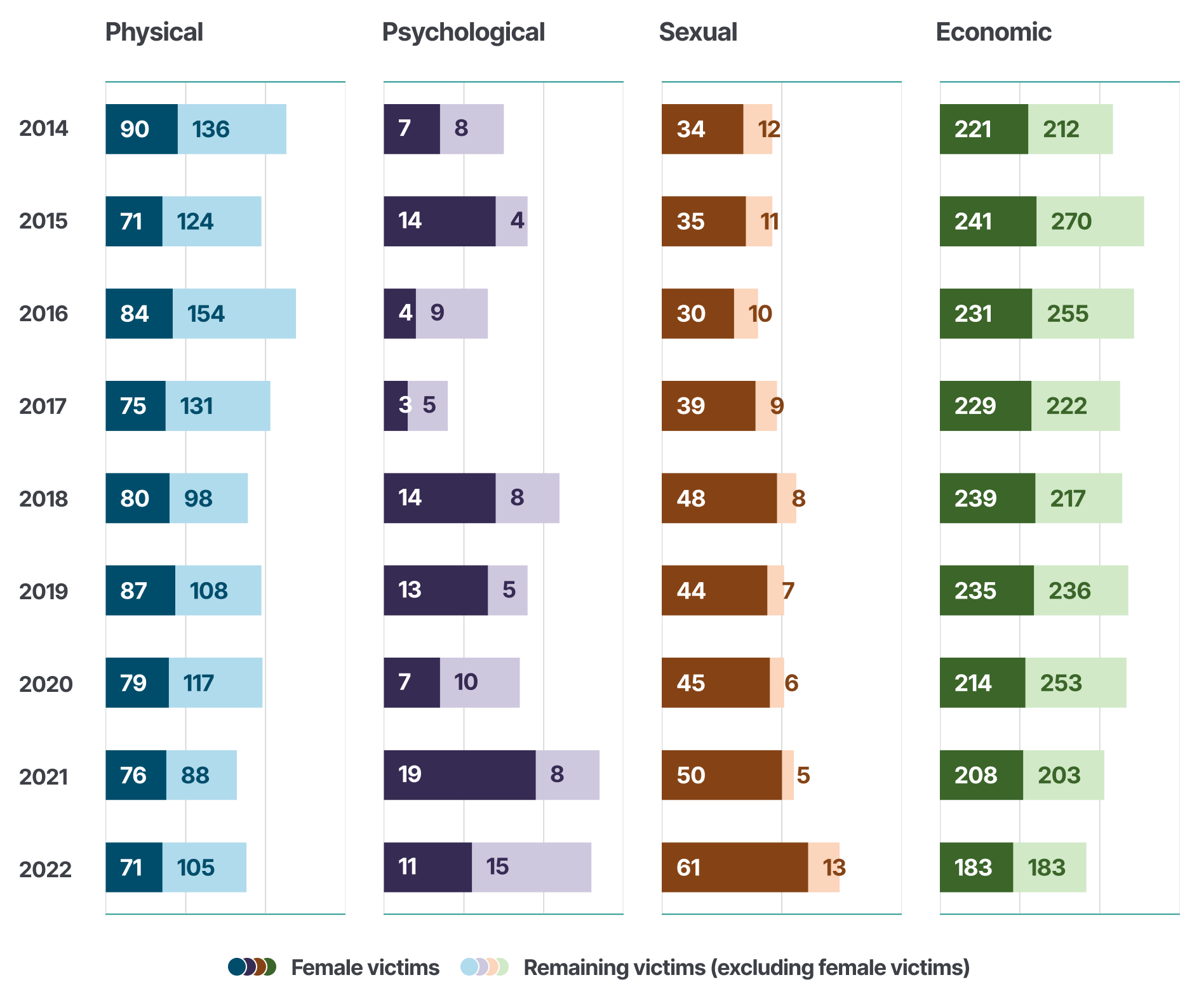
Police record a greater number of women victims of physical domestic violence than of sexual domestic violence annually. Similarly, the results of the latest EU-GBV survey show that, during adulthood, 12 % of women have experienced physical domestic violence (including threats), compared to 4.6 % that have experienced sexual domestic violence.
Femicide: Number of women killed
EIGE defines femicide as ‘killing of women and girls because of their gender’. It is the most severe manifestation of gender-based violence. EIGE’s femicide classification framework distinguishes between killings committed by intimate partners and family members and other forms of femicide, which are less common.
There is no legal definition of femicide in the Latvian Criminal Code. However, national level police data is available on female victims of intimate partner homicide, domestic homicide, and homicide in ‘any relationship’.
Several women are killed by those closest to them
In 2022, 40 women victims of intentional homicide were recorded by police. In the same year, police data shows that 18 women were killed by domestic perpetrators, and 4 were killed by intimate partners.
Figure 6 Annual number of female victims of intimate partner homicide, domestic homicide, and homicide in any relationship recorded by police (Indicator 9), 2014-2022
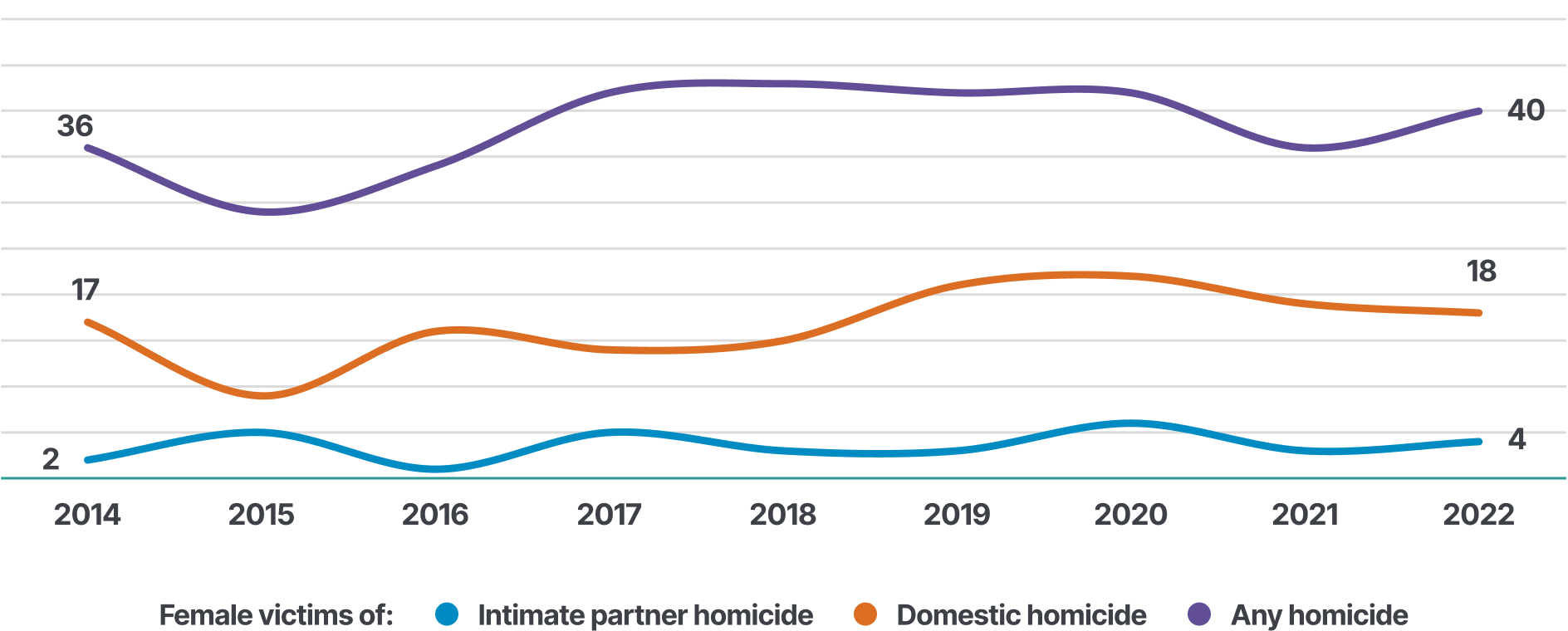
Women are disproportionately affected by intimate partner homicide
In 2022, 100 % of victims of intimate partner homicide were women (4 out of 4). In the same year, women represented 58 % of victims of domestic homicide (18 out of 31).
The data also show that, in 2022, 60 % of all intentional homicide victims by any perpetrator were women (40 out of 67).
Figure 7 Proportion of female victims of intimate partner homicide, domestic homicide, and homicide in any relationship recorded by police (Indicator 9), 2022
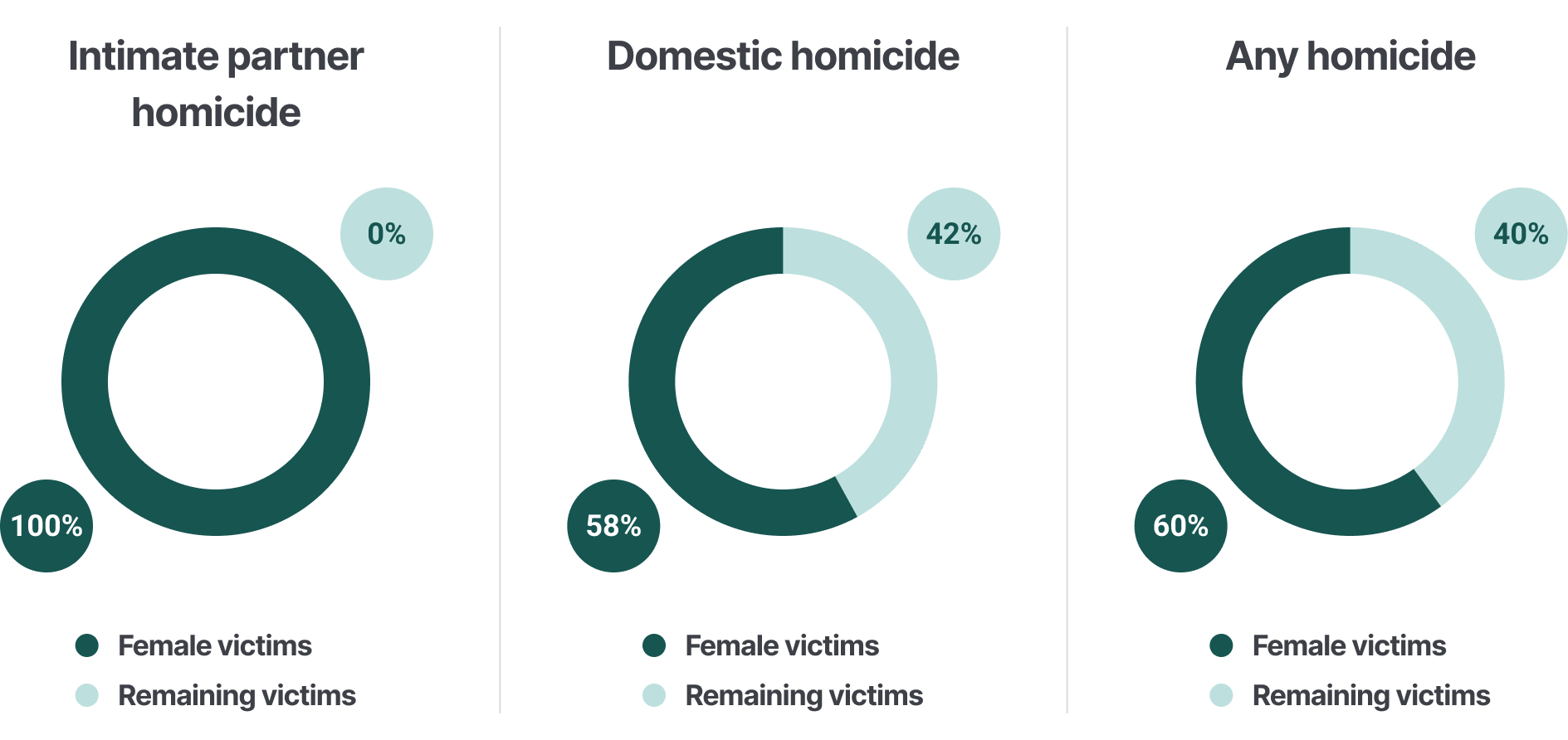
Most femicide victims experience non-lethal forms of gender-based violence before they are killed. Femicide is often the culmination of a pattern of abuse.
According to the latest EU-GBV survey, women victims of intimate partner violence experience significant consequences to their mental and physical wellbeing. However, only about 1 in 4 women victims of intimate partner violence in Latvia (26 %) report to police (based on 2021 data).
Rape: Number of women victims
EIGE defines rape as ‘sexual penetration, whether vaginal, anal or oral, through the use of object or body parts, without consent, using force, coercion or by taking advantage of the vulnerability of the victim’.
In Latvia, rape is criminalised under Article 159 of the Criminal Code. It is defined as ‘an act of sexual intercourse taking advantage of the state of helplessness of a victim or an act of sexual intercourse against the will of the victim by means of violence, threats or using trust, authority or exerting other influence over the victim’.
Several victims of rape are harmed by those closest to them
In 2022, 157 women victims of rape were recorded by police. During the same year, the police recorded 34 women victims of rape by domestic perpetrators, and 10 women victims of rape committed by intimate partners.
Figure 8 Annual number of female victims of intimate partner rape, domestic rape, and rape in any relationship recorded by police (Indicator 8), 2014-2022
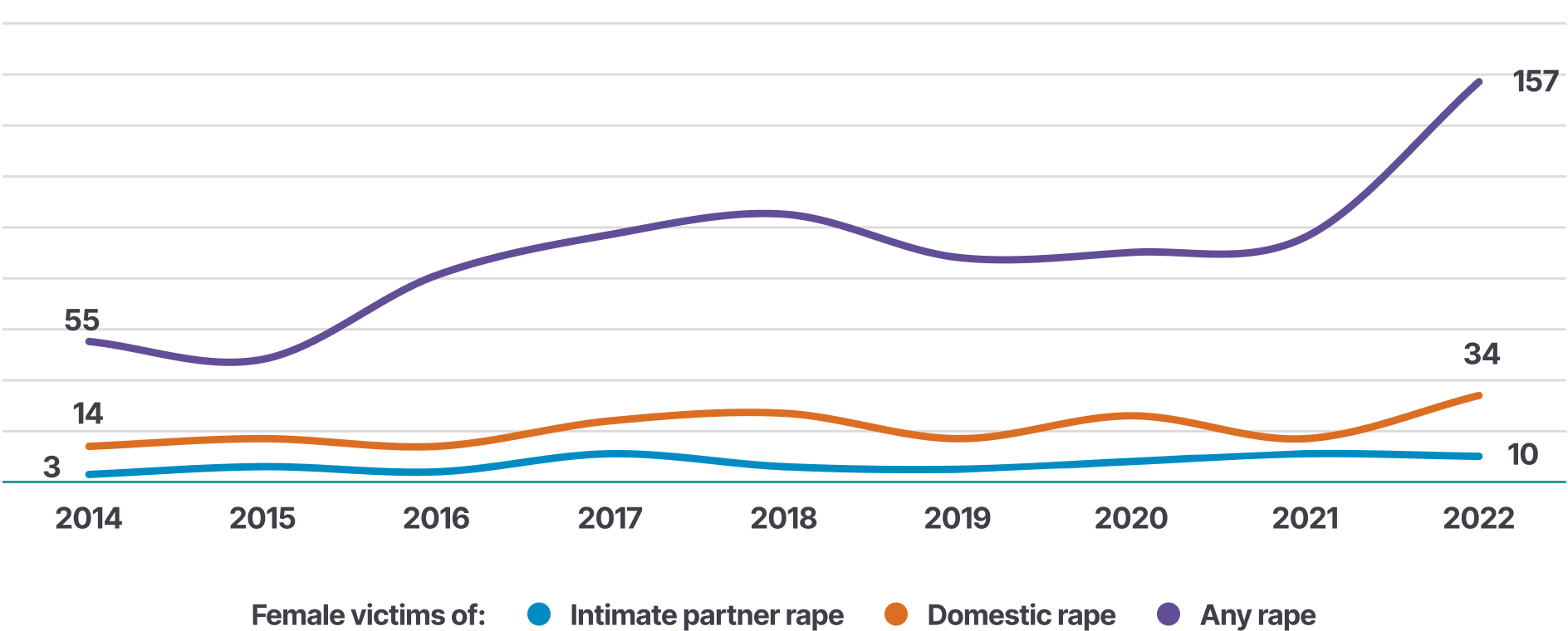
Women are the main victims that suffer from rape
In 2022, women represented all 10 victims of intimate partner rape recorded by police (100 %). During the same year, women comprised 83 % of victims of domestic rape (34 out of 41), and 93 % of victims of rape committed by any perpetrator (157 out of 168).
Figure 9 Proportion of female victims of intimate partner rape, domestic rape, and rape in any relationship recorded by police (Indicator 8), 2022
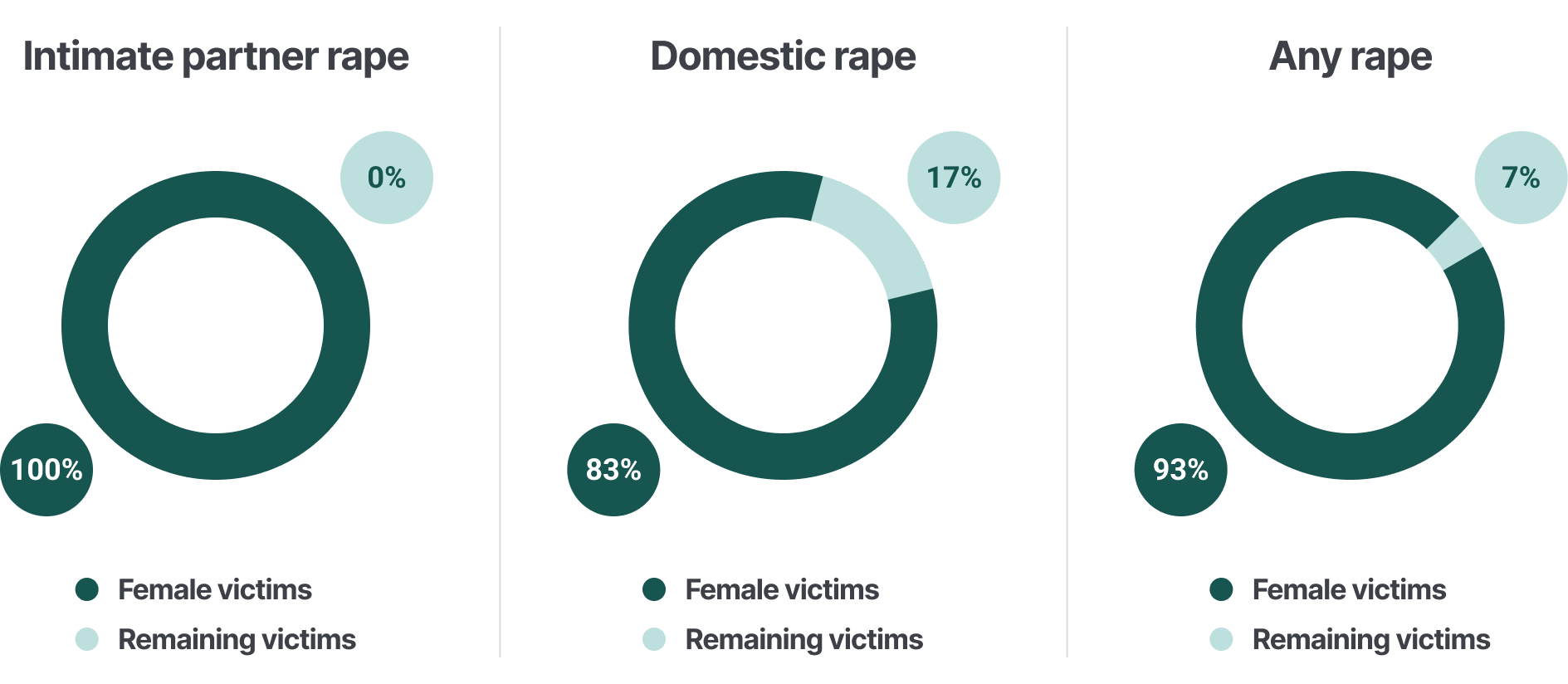
Summary of data availability and next steps
Findings from EIGE’s 2023-2024 data collection exercise in Latvia underscore the persistent threat of intimate partner violence and domestic violence to the safety and well-being of women and girls.
The collection of robust administrative data on intimate partner violence and domestic violence is essential to ensure effective policymaking, resource allocation, and the development of targeted interventions to support victims and prevent further violence.
EIGE’s research shows that, in Latvia, police data is widely available on victims and offences of intimate partner violence and domestic violence. EIGE also managed to retrieve data on victims of specific forms of violence, including physical, psychological, sexual, and economic violence.
Although a legal definition of femicide does not exist in Latvia, data is available on victims of intentional homicide committed by intimate partners, domestic perpetrators, and any perpetrator. Similarly, data has been shared on victims of rape, disaggregated by the victim-perpetrator relationship.
However, data has not been shared on protection orders for victims of violence, or on perpetrators that are reported to police, prosecuted, sentenced, or held in prison. This makes it challenging to explore the extent to which men are brought to justice for violence against women.
In May 2024, the EU adopted Directive (EU) 2024/1385 of the European Parliament and of the Council of 14 May 2024 on combating violence against women and domestic violence. Article 44 establishes that Member States must work with EIGE to collect administrative data on these forms of violence and must adhere to common standards. EIGE remains committed to supporting Member States in their efforts to collect comprehensive, reliable data on violence against women and domestic violence.
Further details on the data collected during EIGE’s 2023–2024 data collection exercise are available in EIGE’s Gender Statistics Database and on its website.
Annexes
Annex 1: List of EIGE’s 13 indicators on intimate partner violence and domestic violence